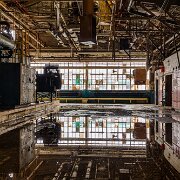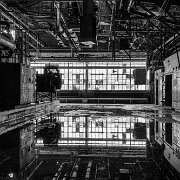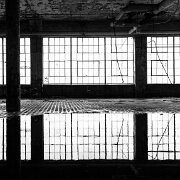
1 Fisher Body Plant 21, located on Piquette Avenue in Detroit, was built in 1919 as part of the Fisher Body Company, which supplied automobile bodies to General Motors (GM). This four-story, reinforced concrete structure was designed in a style characteristic of early 20th-century industrial architecture, emphasizing both functionality and durability. It quickly became a vital hub for producing car bodies, including for popular brands like Cadillac and Buick. Fisher Body was an influential name in the automotive industry, known for pioneering techniques in mass production. At its peak, Fisher Plant 21 employed hundreds of workers who contributed to Detroit’s burgeoning status as the "Motor City."
In 1926, Fisher Body was fully absorbed by General Motors, which continued to operate Plant 21 as a central manufacturing facility. During World War II, the plant shifted gears from car bodies to military production, reflecting Detroit's broader transformation into the "Arsenal of Democracy." After the war, Fisher Plant 21 returned to automobile manufacturing, contributing to the post-war boom in American car culture. However, as the automotive industry evolved, many older plants faced obsolescence, and Plant 21 eventually ceased production in the late 1970s.
In 1926, Fisher Body was fully absorbed by General Motors, which continued to operate Plant 21 as a central manufacturing facility. During World War II, the plant shifted gears from car bodies to military production, reflecting Detroit's broader transformation into the "Arsenal of Democracy." After the war, Fisher Plant 21 returned to automobile manufacturing, contributing to the post-war boom in American car culture. However, as the automotive industry evolved, many older plants faced obsolescence, and Plant 21 eventually ceased production in the late 1970s.

2 Hudson Body Plant . Located at the corner of Conner and Gratiot Avenues, the plant was designed by famed architect Albert Kahn (who also designed Hudson's main factory) and was built in 1925 for a Hudson supplier. Hudson purchased the building in the late 1920's. Hudson bodies were fabricated in the building, then trucked down the street to the main assembly plant on Jefferson Avenue. Hudson closed the plant when they ended operations in Detroit in 1954. In 1956, General Motors purchased the building and it served as a Cadillac stamping plant until the Poletown plant opened in 1985.

3 Hudson Body Plant . Located at the corner of Conner and Gratiot Avenues, the plant was designed by famed architect Albert Kahn (who also designed Hudson's main factory) and was built in 1925 for a Hudson supplier. Hudson purchased the building in the late 1920's. Hudson bodies were fabricated in the building, then trucked down the street to the main assembly plant on Jefferson Avenue. Hudson closed the plant when they ended operations in Detroit in 1954. In 1956, General Motors purchased the building and it served as a Cadillac stamping plant until the Poletown plant opened in 1985.

4 Fisher Body Plant 21, located on Piquette Avenue in Detroit, was built in 1919 as part of the Fisher Body Company, which supplied automobile bodies to General Motors (GM). This four-story, reinforced concrete structure was designed in a style characteristic of early 20th-century industrial architecture, emphasizing both functionality and durability. It quickly became a vital hub for producing car bodies, including for popular brands like Cadillac and Buick. Fisher Body was an influential name in the automotive industry, known for pioneering techniques in mass production. At its peak, Fisher Plant 21 employed hundreds of workers who contributed to Detroit’s burgeoning status as the "Motor City."
In 1926, Fisher Body was fully absorbed by General Motors, which continued to operate Plant 21 as a central manufacturing facility. During World War II, the plant shifted gears from car bodies to military production, reflecting Detroit's broader transformation into the "Arsenal of Democracy." After the war, Fisher Plant 21 returned to automobile manufacturing, contributing to the post-war boom in American car culture. However, as the automotive industry evolved, many older plants faced obsolescence, and Plant 21 eventually ceased production in the late 1970s.
In 1926, Fisher Body was fully absorbed by General Motors, which continued to operate Plant 21 as a central manufacturing facility. During World War II, the plant shifted gears from car bodies to military production, reflecting Detroit's broader transformation into the "Arsenal of Democracy." After the war, Fisher Plant 21 returned to automobile manufacturing, contributing to the post-war boom in American car culture. However, as the automotive industry evolved, many older plants faced obsolescence, and Plant 21 eventually ceased production in the late 1970s.

5 Fisher Body Plant 21, located on Piquette Avenue in Detroit, was built in 1919 as part of the Fisher Body Company, which supplied automobile bodies to General Motors (GM). This four-story, reinforced concrete structure was designed in a style characteristic of early 20th-century industrial architecture, emphasizing both functionality and durability. It quickly became a vital hub for producing car bodies, including for popular brands like Cadillac and Buick. Fisher Body was an influential name in the automotive industry, known for pioneering techniques in mass production. At its peak, Fisher Plant 21 employed hundreds of workers who contributed to Detroit’s burgeoning status as the "Motor City."
In 1926, Fisher Body was fully absorbed by General Motors, which continued to operate Plant 21 as a central manufacturing facility. During World War II, the plant shifted gears from car bodies to military production, reflecting Detroit's broader transformation into the "Arsenal of Democracy." After the war, Fisher Plant 21 returned to automobile manufacturing, contributing to the post-war boom in American car culture. However, as the automotive industry evolved, many older plants faced obsolescence, and Plant 21 eventually ceased production in the late 1970s.
In 1926, Fisher Body was fully absorbed by General Motors, which continued to operate Plant 21 as a central manufacturing facility. During World War II, the plant shifted gears from car bodies to military production, reflecting Detroit's broader transformation into the "Arsenal of Democracy." After the war, Fisher Plant 21 returned to automobile manufacturing, contributing to the post-war boom in American car culture. However, as the automotive industry evolved, many older plants faced obsolescence, and Plant 21 eventually ceased production in the late 1970s.

6 Fisher Body Plant 21, located on Piquette Avenue in Detroit, was built in 1919 as part of the Fisher Body Company, which supplied automobile bodies to General Motors (GM). This four-story, reinforced concrete structure was designed in a style characteristic of early 20th-century industrial architecture, emphasizing both functionality and durability. It quickly became a vital hub for producing car bodies, including for popular brands like Cadillac and Buick. Fisher Body was an influential name in the automotive industry, known for pioneering techniques in mass production. At its peak, Fisher Plant 21 employed hundreds of workers who contributed to Detroit’s burgeoning status as the "Motor City."
In 1926, Fisher Body was fully absorbed by General Motors, which continued to operate Plant 21 as a central manufacturing facility. During World War II, the plant shifted gears from car bodies to military production, reflecting Detroit's broader transformation into the "Arsenal of Democracy." After the war, Fisher Plant 21 returned to automobile manufacturing, contributing to the post-war boom in American car culture. However, as the automotive industry evolved, many older plants faced obsolescence, and Plant 21 eventually ceased production in the late 1970s.
In 1926, Fisher Body was fully absorbed by General Motors, which continued to operate Plant 21 as a central manufacturing facility. During World War II, the plant shifted gears from car bodies to military production, reflecting Detroit's broader transformation into the "Arsenal of Democracy." After the war, Fisher Plant 21 returned to automobile manufacturing, contributing to the post-war boom in American car culture. However, as the automotive industry evolved, many older plants faced obsolescence, and Plant 21 eventually ceased production in the late 1970s.

11 Fisher Body Plant 21, located on Piquette Avenue in Detroit, was built in 1919 as part of the Fisher Body Company, which supplied automobile bodies to General Motors (GM). This four-story, reinforced concrete structure was designed in a style characteristic of early 20th-century industrial architecture, emphasizing both functionality and durability. It quickly became a vital hub for producing car bodies, including for popular brands like Cadillac and Buick. Fisher Body was an influential name in the automotive industry, known for pioneering techniques in mass production. At its peak, Fisher Plant 21 employed hundreds of workers who contributed to Detroit’s burgeoning status as the "Motor City."
In 1926, Fisher Body was fully absorbed by General Motors, which continued to operate Plant 21 as a central manufacturing facility. During World War II, the plant shifted gears from car bodies to military production, reflecting Detroit's broader transformation into the "Arsenal of Democracy." After the war, Fisher Plant 21 returned to automobile manufacturing, contributing to the post-war boom in American car culture. However, as the automotive industry evolved, many older plants faced obsolescence, and Plant 21 eventually ceased production in the late 1970s.
In 1926, Fisher Body was fully absorbed by General Motors, which continued to operate Plant 21 as a central manufacturing facility. During World War II, the plant shifted gears from car bodies to military production, reflecting Detroit's broader transformation into the "Arsenal of Democracy." After the war, Fisher Plant 21 returned to automobile manufacturing, contributing to the post-war boom in American car culture. However, as the automotive industry evolved, many older plants faced obsolescence, and Plant 21 eventually ceased production in the late 1970s.













Reflections